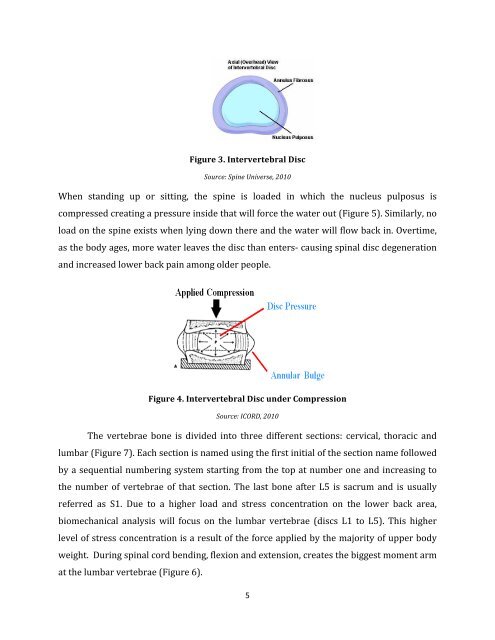Intervertebral Disk Replacement - Keivan Anbarani's Electronic ...
Intervertebral Disk Replacement - Keivan Anbarani's Electronic ...
Intervertebral Disk Replacement - Keivan Anbarani's Electronic ...
Create successful ePaper yourself
Turn your PDF publications into a flip-book with our unique Google optimized e-Paper software.
Figure 3. <strong>Intervertebral</strong> Disc<br />
Source: Spine Universe, 2010<br />
When standing up or sitting, the spine is loaded in which the nucleus pulposus is<br />
compressed creating a pressure inside that will force the water out (Figure 5). Similarly, no<br />
load on the spine exists when lying down there and the water will flow back in. Overtime,<br />
as the body ages, more water leaves the disc than enters-‐ causing spinal disc degeneration<br />
and increased lower back pain among older people.<br />
Figure 4. <strong>Intervertebral</strong> Disc under Compression<br />
Source: ICORD, 2010<br />
The vertebrae bone is divided into three different sections: cervical, thoracic and<br />
lumbar (Figure 7). Each section is named using the first initial of the section name followed<br />
by a sequential numbering system starting from the top at number one and increasing to<br />
the number of vertebrae of that section. The last bone after L5 is sacrum and is usually<br />
referred as S1. Due to a higher load and stress concentration on the lower back area,<br />
biomechanical analysis will focus on the lumbar vertebrae (discs L1 to L5). This higher<br />
level of stress concentration is a result of the force applied by the majority of upper body<br />
weight. During spinal cord bending, flexion and extension, creates the biggest moment arm<br />
at the lumbar vertebrae (Figure 6).<br />
5


